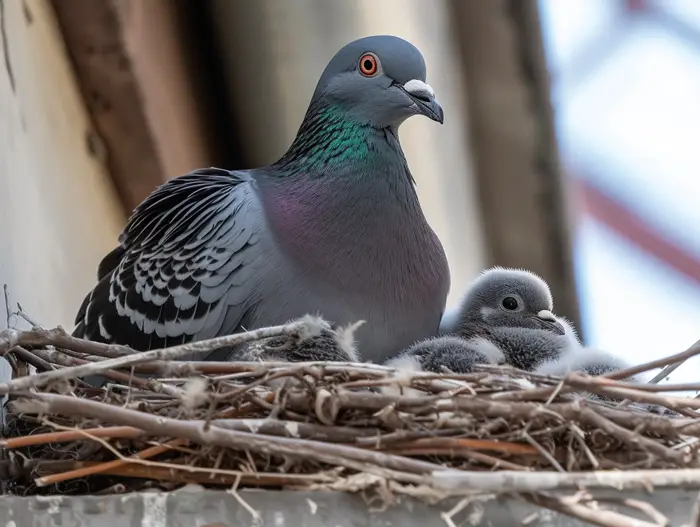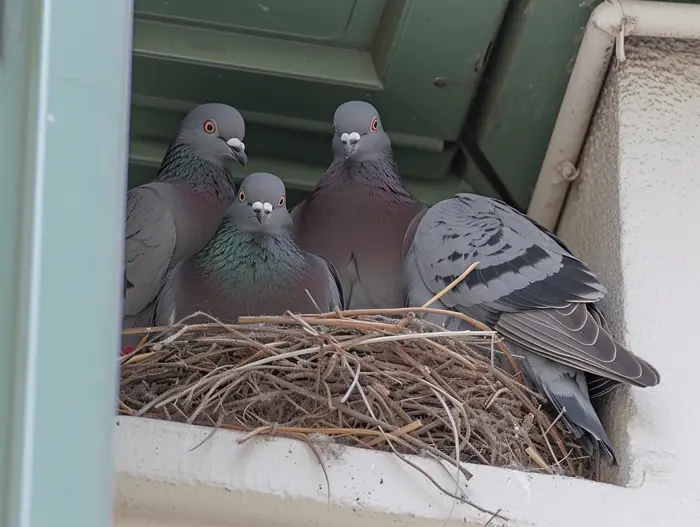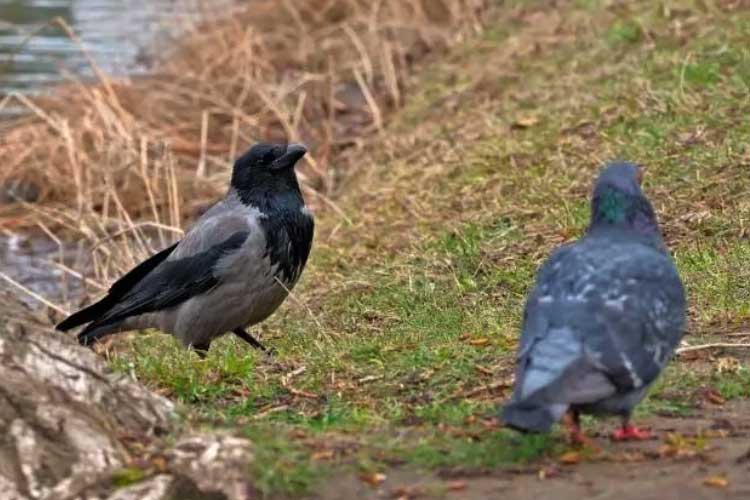Pigeon Attraction: What Draws Them to Roofs
Have you ever wondered why pigeons seem to have a special affinity for rooftops? It’s a common sight in many urban areas, where these feathered creatures gather in large numbers, perched and cooing on the rooftops. As an expert in avian behavior, I’ve delved into the fascinating world of pigeons and their attraction to roofs. In this article, I’ll uncover the reasons behind this peculiar behavior and shed light on what exactly draws pigeons to these elevated structures.
Roofs, with their strategic vantage points, offer pigeons a prime location to survey their surroundings. These elevated perches give them a clear view of potential threats or sources of food. But it’s not just the panoramic view that entices pigeons. The architecture of rooftops provides them with ample shelter and protection from the elements. From the cozy nooks and crannies to the warm and dry surfaces, roofs offer the perfect haven for these adaptable birds. Join me as we explore the various factors that make rooftops irresistible to our feathered friends.
The Strategic Vantage Points of Roofs

When it comes to pigeons and their affinity for rooftops, strategic vantage points play a significant role. As these birds navigate through the urban landscape, rooftops provide them with unique advantages that make them an irresistible choice. Let’s explore these strategic vantage points that attract pigeons to roofs:
- One of the key reasons why pigeons favor rooftops is the unobstructed view they offer. From up high, pigeons can survey their surroundings in all directions, helping them keep a keen eye on potential predators or sources of food. Safety is a top priority for these birds, and rooftops provide them with an ideal vantage point to stay vigilant.
- Rooftops offer pigeons a safe haven from the elements. Whether it’s scorching heat or pouring rain, these birds can find respite on roofs. The architecture of rooftops, with its cozy nooks and crannies, allows pigeons to find shelter from harsh weather conditions. Additionally, the elevated position ensures that they are safe from ground-level disturbances and predation.
- Pigeons are attracted to the warmth and dryness that rooftops offer. The materials used in roof construction, such as asphalt or concrete, tend to retain heat, creating a comfortable environment for these birds. This is particularly appealing during colder seasons when the ground may be damp and cold. Additionally, rooftops often provide a better thermal insulation compared to other outdoor surfaces, making them an attractive spot for pigeons to perch and roost.
- Rooftops also provide abundant nesting opportunities for pigeons. The architecture of rooftops, with ledges, chimneys, and vents, creates perfect spots for pigeons to build their nests. These birds are known for their strong homing instinct, and rooftops mimic the cliff ledges and crevices that they naturally gravitate towards. The flat, stable surfaces, combined with the concealment provided by rooftop structures, make them an ideal location for pigeon families to thrive.
Panoramic Views and Awareness of Surroundings
When it comes to pigeons and their choice of rooftops, one of the major factors is the panoramic view that these elevated positions offer. Being on a rooftop gives pigeons a clear and unobstructed view of their surroundings. It allows them to scan the area for any potential threats or sources of food, which are essential for their survival.
From the top of a building, pigeons can spot predators such as birds of prey or feral cats, allowing them to take evasive action and stay safe. This high vantage point also enables pigeons to keep an eye on other pigeons, as they are social creatures that form flocks.
Additionally, being on a rooftop gives pigeons a sense of security and control over their surroundings. They have an advantage over ground-dwelling birds because they can see and react to threats from all directions. This awareness helps them make quick decisions and avoid danger.
Shelter and Protection from the Elements
Another allure of rooftops for pigeons is the shelter and protection they provide. When the weather is unfavorable, rooftops offer a dry and warm environment, shielding pigeons from rain, snow, or extreme temperatures. The architecture of rooftops often includes cozy nooks and crannies where pigeons can find refuge and rest.
Moreover, rooftops act as a barrier to strong winds, which can make flight difficult for pigeons. Being on a rooftop allows them to take shelter and conserve energy, preventing unnecessary exposure to the elements.

Abundant Nesting Opportunities
Finally, rooftops are attractive to pigeons because they offer abundant nesting opportunities. Pigeons are known for their ability to build nests in various locations, and rooftops provide them with ample options. The architectural features of rooftops, such as ledges, gutters, and air vents, make ideal nesting spots for these resourceful birds.
Nesting on rooftops also offers pigeons protection from ground predators, such as rats or snakes, that may try to raid their nests. This elevated position helps safeguard their eggs and young chicks, ensuring their survival.
Ample Shelter and Protection from the Elements
When it comes to choosing a nesting spot, pigeons prioritize ample shelter and protection from the elements. Rooftops offer these essential features, making them an ideal habitat for these birds. Here’s why pigeons find rooftops so attractive:
- Shelter: Rooftops provide a safe haven for pigeons to escape from the unpredictable weather conditions. Whether it’s scorching heat or pouring rain, pigeons can find solace under the eaves or in the cozy nooks and crannies of a rooftop. This protection allows them to stay dry and comfortable, preventing potential illness or harm.
- Protection from Predators: The elevated height of rooftops gives pigeons an advantage against ground predators. By perching on rooftops, they are out of reach for most predators, such as cats or dogs. Pigeons have a natural instinct to seek higher ground, increasing their chances of survival. Being on a rooftop provides them with peace of mind, knowing that they are less vulnerable to potential threats.
- Escape from Strong Winds: Rooftops offer pigeons a respite from strong winds that can be dangerous and cause their feathers to ruffle. By finding a sheltered spot on a rooftop, pigeons can protect themselves from the relentless gusts and ensure their feathers remain in good condition for flying and staying warm.
- A Dry and Warm Surface: Pigeons are attracted to dry and warm surfaces, and rooftops fit the bill perfectly. The materials used in constructing rooftops retain heat, allowing pigeons to bask in the warmth during colder periods. This cozy environment is not only comfortable but also helps them conserve energy that they would otherwise use to regulate body temperature.
Pigeons are drawn to rooftops because they offer ample shelter and protection from the elements. With their instinctual need for safety and comfort, it’s no wonder that rooftops provide the ideal habitat for these birds. The elevated position, combined with the cozy and dry surfaces, creates an inviting space for pigeons to thrive. So next time you spot a pigeon perched on a rooftop, remember they’ve found the perfect spot to call home.
Cozy Nooks and Crannies: Perfect Hideouts
When it comes to seeking shelter and finding a safe place to rest, pigeons are expert navigators. Their keen sense of survival leads them to explore various nooks and crannies, ultimately settling on rooftops as their preferred hideouts. But why do pigeons find rooftops so alluring? Let’s explore the cozy features that make these aerial creatures flock to the tops of buildings.

- Ample Protection: Roofs provide pigeons with a sense of security. The elevated platform shields them from ground predators that may pose a threat to their safety. It’s like having their very own private retreat, far away from potential dangers. This inherent need for protection drives pigeons to seek out rooftops as their go-to sanctuary.
- Escape from the Elements: Harsh weather conditions can be a challenge for birds, but rooftops offer an escape. When rain starts to pour or wind gusts become strong, pigeons can find solace in the sheltered eaves and corners of a roof. The dry and warm surface also prevents them from getting soaked or chilled. So, when the elements turn fierce, pigeons know they can find refuge atop a rooftop.
- A Panoramic View: Pigeons are not only looking for safety and shelter, but they also value a good view. Rooftops provide a vantage point that allows them to have a clear panorama of their surroundings. This visibility gives them a sense of control over their environment, enabling them to easily spot potential threats or sources of food. It’s like having their own private lookout tower!
So, it’s no wonder that pigeons are drawn to the cozy nooks and crannies of rooftops. They offer the perfect hideouts, complete with ample protection, escape from the elements, and a panoramic view of their surroundings. These features provide the ideal habitat for pigeons to rest, hidden from harm’s way and able to keep a watchful eye on the world below.
Conclusion
Pigeons are attracted to rooftops for a variety of reasons. First and foremost, rooftops provide pigeons with a panoramic view of their surroundings, allowing them to stay vigilant and spot potential threats or sources of food. Additionally, being on a rooftop gives pigeons a sense of security and control, as they are elevated and away from ground predators.
Moreover, rooftops offer shelter and protection from the elements, including unfavorable weather conditions and strong winds. Pigeons prioritize ample shelter and protection when choosing a nesting spot, and rooftops provide these essential features.
Overall, the allure of rooftops for pigeons lies in the combination of a panoramic view, security, and protection from the elements. These factors make rooftops the perfect hideouts for pigeons to rest and keep a watchful eye on the world below. So, it’s no wonder that pigeons are often seen perched on rooftops in urban areas.






